SLS Objectives:
- To manage the Forest Management Agreement area for a sustainable timber supply
- To manage the Forest Management Agreement area in a manner that protects the Environment, Biodiversity, Water, Wildlife and Public Values
- To reclaim and reforest all harvested areas
- To harvest 95000m3 from the McLean Creek Compartment from 2015-2016
- To continue to have meaningful communication with the public and stakeholders early in the planning process including collaborative planning
Public Feedback:
- Concerned about the cumulative effects on the landscape.
- Heavily used area on the weekends, things like access control are important.
- Watershed management to minimize sedimentation into the water course,
- Consider quality and quantity of water
- Protect springs and wet lands
- Would like to see SLS go above and beyond ground rules in regards to watershed protection
- Concerned about Sensitive wildlife habitat in the area.
- Would like to see more public education on the importance of protecting forests and the value of forest management in regards to watershed management.
- Would like to see continued research on watersheds and for SLS to provide existing studies that it has to the public.
- Consider designing smaller cutblocks to reduce snow sublimation
Spray Lake Sawmills Response:
- SLS will evaluate and incorporate springs identified by others when creating the plan.
- SLS reclaims all roads after operations to minimize access. SLS will work closely with ESRD to restrict access where necessary.
- SLS will work with ESRD in regards to sensitive wildlife habitat. (Time of harvest, planning the cutblocks)
- SLS is creating video’s that can be a resource for public education in how we manage for water. There is also information on the SLS website regarding forest management practices: https://spraylakesawmills.com/woodlands/forestry-101/
- SLS will minimize roads in harvest block and follow Operational Ground Rules to prevent sediment from entering water courses.
- SLS designs cutblock of various sizes by following natural topography and vegetation types. Cutblocks are designed to emulate fire patterns.
- SLS has conducted “Equivalent Clearcut Area” Modelling as part of the detailed Forest Management Plan. This model is used to predict the potential change in water yield following forest harvesting and the associated rate of hydrologic recovery time. The model output was interpreted by a hydrologist from the university of Alberta
- SLS commissioned a water quality monitoring program. The program was conducted by an aquatic ecologist from the Suncor Centre of Mount Royal College. The collected data suggests that there is no measured, significant difference in the streams influenced by SLS when compared to the differences measured in the control stream not influenced by SLS. A summary of the findings can be found in the 5 year stewardship report: https://spraylakesawmills.com/wp-content/uploads/2013/08/5%20year%20Stewardship%20Report_July1a.pdf (starting at page 57)
- SLS will continue to evaluate scientific findings to see if they are appropriate to incorporate into its best management practices
- SLS will continue to look for opportunities to evaluate and monitor water sustainability, quality and the impact of cumulative effects.
- SLS will follow the Alberta Wetlands Policy that has been developed under the Water For Life initiative.
- SLS will post a map to the Blog showing:
- Hillshade
- Roads
- Water
- Previously harvested cutblocks symbolized by age
- Proposed harvest areas
- Trails


